Volkswagen Wheels and Tires

| Wheels and Tires Index | ←You are Here | ||
| Bolt Patterns and Offset | |||
| Tire Sizing | |||
| Tire Size Calculator | |||
| Wheels | |||
| Torsion Bar Indexing | |||
| Lengthened Trailing Arms | |||
The wheels that came with your VW are generally fine for most VW drivers. These factory wheels have the proper backspacing to allow your stock sized tires to fit without fitting problems and to allow for optimal steering and wheel bearing life. They are designed for a "skinnier" tires which are better for traction than you would think. The tires that came with your VW on the other hand have most likely been replaced or have rotted off by now. Tire technology has also made leaps and bounds over the last many decades and tire choices abound. And since many VWers prefer to run wider and/or taller tires for better off road performance, looks and the perception of increased street handling, there are many options to allow for their peculiar desires.
Type 1 Standard Beetle
Those looking to go with larger tires are faced with the possibility of clearance problems. And depending on the size of tire you would like to run, the rear fenders can get in the way. So larger tires will often necessitate fender modifications to clear them.
On 1958-1966 sedans, the rear inner fenderwell will limit tire height to around 29 inches. If you take a mallet to the box shaped area at the front end of the rear fenderwells, you can gain another inch of tire clearance.
On 1967-1968 swing axle sedans or sedans with Type 3 swing axle transaxle, you can get away with a little over 30 inch tires.
Swing-axle sedans prior to 1958 as well as 1968 and later IRS sedans have long torsion bars that protrude considerably into the rear wheelwells. These are the big limiting point for rear tire clearance. You can measure the distance between the rear end of the torsion bar tube and the center of your axle to determine the maximum radius tire you can use. Double this number and subtract an inch or so and that should be the largest tire you should run.
In the front you can go pretty big, depending on how much you are willing to cut away at those fenders. But for those looking for a taller and wider street tire that fits in the stock fenders (sometimes after lowering the suspension), you may be looking at wider fenders or narrowing the front end to allow the tires to fit. Narrowing the front end can make your Beetle look cool with the wide tires you were able to fit under the fenders, but this will have a negative impact on steering on and off road.
Class 11 Beetles
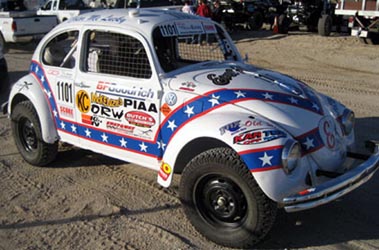
The Class 11 guidelines limit what can be done to modify a Beetle and require stock wheels. These vehicles generally run LT215/75 R15, LT235/75 R15 or 7.00 x 15 (29.5inch) tires on stock 15" x 5.5" or 15" x 4.5"wheels. These vehicles do pretty well off road with really little modification.
181 Thing
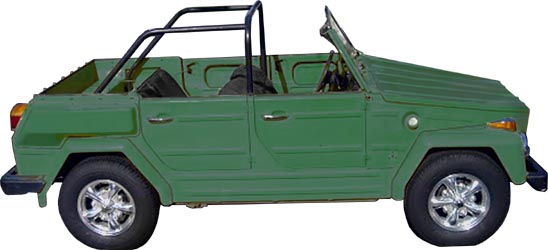
215/75 R15 and Empi Wheels
The 1968-1972 German models had 165/15 tires on 4.5 x 15" rims; later models had 185/14 tires on 5 x 14" rims as original equipment. The 1973 and 1974 Mexican-built for U.S Things came stock with Thing-specific 14" wheels and 15" ones were optional and rare in the US. The original stock tire on these were either Continental or Goodyear185SR14.
14" bus wheels will rub on the front spindle, some more than others, some all the time, some only while cornering.
15" Beetle and Ghia rims are identical, possibly type 3 rims also. These will clear a Thing spindle but have too much negative offset and the fronts may rub the pan at full lock.
15" x 6" Aftermarket Chromies have about the same off-set as the factory Thing rims and work well, no rubbing, except with some tires at the front on the pan.
ref: The Samba
In regards to tire size, 215/75 R15 tires will fit without suspension or fender modifications for street use but will contact the back of the headlights at full suspension compression. The largest tire that will work with stock metal fenders is a 205/75 R15.
Everything else that you want to know about Thing tires can be found at The Samba
Type 2 Bus
A VW bus is more ready for off road travels than you might first think. Narrow 5 (5 x 112mm) wheels can run up to 205/75 R15s without modification when using a Mercedes ET37 6.5x15 wheel. Larger tires up front will require a lift and/or other mods to fit without rubbing.
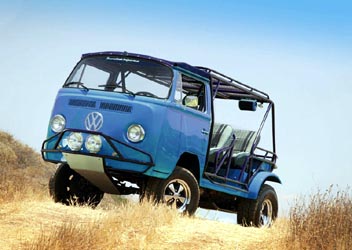
In the rear, you can go as high as 235/75 R15 without modification or 30"x9.5"x15 if you have he proper offset wheels. Anything wider than 235mm or 9.5" will require fender trimming or a significant lift. Modifications to the body will allow you to go as high as 33"x12.5" on a 15" wheels, which is a pretty big tire.
If you go with wider tires, check that the sliding door doesn't hit the rear tire. If it will come in contact with the tire then you (or someone else) can accidentally bend the corner of the door if you open it too fast. To solve this problem, you can go with a narrower tire or modify the slide and stop for the door.
Standard steel rim T2 / T3
211 601 027 H Scheibenrad stahl,
5.5Jx14H1 ET39 (Offset 39 mm)
(From chassis number 211 2000 001 onwards, All years '71 - '92)
These rims can still be ordered from VW, around $50 each.
Alloy Rims
255 601 027 Scheibenrad 'ALU',
6.0Jx14H2 ET30 5/112 (Offset 30 mm)
(1980 - 1985, 12 round holes)
No Longer Available from VW
251 601 025 091 Scheibenrad 'ALU',
6.0Jx14H2 ET30 5/112 (Offset 30 mm)
(1985-1992, 5 spoke)
No Longer Available from VW
Mercedes wheel
ET37 6.5 x 15h2
5 x 112 bolt pattern
See hrps.demon.nl
Baja Karmann Ghias, Squarebacks, Fastbacks, Notchbacks and other Creations
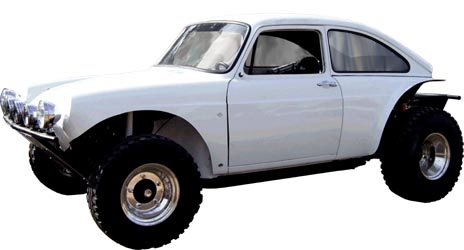
BugZyla's Fastback
These are more common than you think but plan on a lot of body modification and/or fabrication to get what you want. Tire/wheel size and style are all up to what you want to put into your creation and/or what you have available. Of note, the front end of a Type III is different than the front end of a Type I. The Type three has longer trailing arms, is wider and has ball joints that are field serviceable without the need for a press.
Super Beetles
This generally isn't as desirable a platform for a Baja rig as a regular Beetle as it is more challenging to setup properly. The front suspension is integrated into the body which makes it difficult to do a body lift to fit larger tires. Fiberglass for Supers is more difficult to find (Glass-Action). And the real limiting factor of the Supers is the McPherson Struts used in the front.
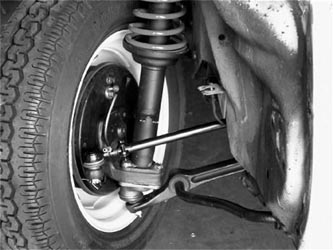
Super Beetle Strut
The McPherson Struts don't allow for tweaking like the torsion bars on other early VWs. Simply adding a longer coil or spacers is going to have an undesirable consequence on camber angles and handling. An although great for street use, the shock itself also isn't durable enough for off road abuse. Hard and frequent bumps can bend the shaft rod, or aerate the oil in the shock to the point that it fails or can cause shock seals to blow out their oil and die. You can relocate the struts, control arms and steering, but this can be an epic task to get right and may not be worth the effort. Many have replaced the front ends with traditional VW front ends or gone with a different front end altogether.
But despite the front end challenge on the Super Beetles, many of these have been converted to Bajas and used off road.
VW Rabit rear springs have been used to augment the front struts on Supers and to provide a bit of front end lift.
Body Lifts
Body lifts are sometimes used to lift the body 2-3 inches higher above the pan to help clear larger tires. This raises the center of gravity to a degree and doesn't help with suspension travel and performance.
Reindexing Torsion Bar
Reindexing of the torsion bars is one of the common methods of adjusting the ride height up or down in a VW. Charts, calculator and torsion bar information can be found on our Torsion Bar Indexing Page.
Bus Reduction Boxes
Type 2 reduction boxes can be used to move the wheel back to increase tire clearance, down to allow for greater clearance or a combination of the each. These will also change your final gearing, which can help with running taller tires at all speeds.
Bus reduction boxes can provides your auto with a 3.5 inch longer and a 6 inch wider wheel base.
Ref:
Lengthened Trailing Arms
Lengthened swing arms are commonly used by VW offroaders to increase the tire track (width) and move the tires back for more clearance as well as increased suspension travel, which is desirable for absorbing the shock of landings after jumps and allow for greater articulation over uneven terrain - such as when driving over rocks. More information on this can be found on our Lengthened Trailing Arms Page.
Lift Spindles
Since most aircooled VWs are rear wheel drive only, you can adjust the front ride height by using a raised or lowered front spindle. And if you are handy with a welder, you can possibly make your own suspension and steering components. There is obvious danger in this should your work be less than perfect.
Blind Chicken DIY 2.25 lift spindles
Tweeds Innovative Designs 3.5" lift ball joint spindles
Tweeds Innovative Designs 3" lift king pin spindles
Lifting the front may help you level a VW with a raised rear and allow for larger tire fitment in the front without the need for modifying the front fender. It can also significantly increase ground clearance and give you that All American Redneck look when you max out the tires that will fit under the stock fenders. The center of gravity is of course increased, carrying it's regular drawbacks.
Tire Pressures
Lighter vehicle (gutted bugs) will require lighter pressures and heavier vehicles (heavy Bajas or Busses) will require higher pressures.
| Front PSI | Rear PSI | |
| Non competition sedan | 10-12 | 14-15 |
| Road racing | 14-16 | 16-18 |
| Rocky terrain | 15-17 | 17-20 |
| High speed long travel | 22-25 | 22-25 |
Tire Sealant
There are mixed thoughts on sealant use. Some feel that it is good insurance and helps balance the tires. Others feel that it hardens, doesn't work and will damage the tires over time.
Some will damage aluminum wheels so make sure yours is compatible with your wheels if you plan on running a sealant.
Back in the old days, racers would use condensed milk as a sealant. That would surely make removing a tire from a rim much more memorable.
Wheels
Information on VW wheels can be found in our VW Wheels Page.
Bolt Patterns
Information on VW bolt patterns can be found in our VW Bolt Pattern Page.
Wheels Bolts
The stock wheel bolts are fine for stock wheels, but can be a bit too short to properly secure thicker wheels. For thicker wheels, you can get longer bolts or convert to studs and use lug nuts like non VWer. Studs will also make tire changes a little easier.
Front/Rear Tire Sizing
Having 4 of the same sized tire make tire rotation easier and allows you to pack a single full size spare. On a 4x4, having the same size tires front and back is important since they will all be turning at the same RPMs and having a different sized tire up front will lead to driveline binding. But on a rear wheel drive VW, you have the option of putting a taller and more aggressive tire in the rear to dig into loose earth while using a skinnier, smaller and lighter tire up front to work as a rudder in mud, sand and loose soil without adding too much unsprung weight.
Tire Size
All the info that you will need to know about how tires are sized can be found in our VW Tire Sizing Page. There is also a Tire Size Calculator there for your own personal pleasure.
Please feel free to link to this site so that others can find it. It's easy to link to this site, just copy one of the texts below onto your web page::
Copyright © 2000-2010